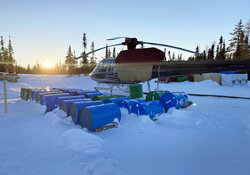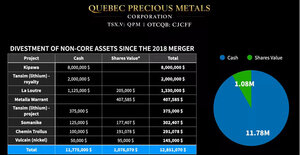 Well-known and highly regarded throughout the mining and exploration community, Mercenary Geologist Mickey Fulp knows stocks as well as rocks. When he's not poring over financial reports, drill results and commodity trends, he's out in the field checking properties of some of the companies he follows—whether the treks take him just below the U.S.-Mexican border, over to Haiti or all the way to Armenia. In this exclusive Gold Report interview, Mickey shares his thoughts about some of his favorites in the sector and reminds investors, "Do your own due diligence, dude."
Well-known and highly regarded throughout the mining and exploration community, Mercenary Geologist Mickey Fulp knows stocks as well as rocks. When he's not poring over financial reports, drill results and commodity trends, he's out in the field checking properties of some of the companies he follows—whether the treks take him just below the U.S.-Mexican border, over to Haiti or all the way to Armenia. In this exclusive Gold Report interview, Mickey shares his thoughts about some of his favorites in the sector and reminds investors, "Do your own due diligence, dude."The Gold Report: You've been traveling quite a bit this summer.
Mickey Fulp: Yes, I focused mainly on the northern tier of North America, which is what I generally do in the summertime. I looked at some gold companies, some uranium companies and some rare earth companies; those are the sectors I'm following. I was in the Yukon, Saskatchewan, Northwest Territories, Quebec, Wyoming, Idaho, Armenia, Haiti—to name a few places. All in all, it was quite a busy summer.
TGR: You've gone to some remote places, which can be fun but also arduous traveling. From a geologist's perspective, it's apparent why you, as the Mercenary Geologist, look at your sectors from the mining angle. Each is so different in terms of what drives value, though, how do you build expertise in these three different sectors?
MF: All are quite different in what drive their values. I study commodities and commodity trends as part of my basic research. As you may be aware from my recent Mercenary Musing called The Trouble with Geologists, I'm an economic geologist. I meld both economics and geology disciplines. I'm always looking at sectors that appear undervalued, trying to determine whether there are upcoming catalysts that will tend to make those sectors appreciate.
TGR: What are the key elements that help you decide whether a sector is undervalued? Are you looking at company financials? At the overall sector relative to other investment opportunities?
MF: That's a very good question. It's basic commodities study. For instance, gold drives the Venture and the Toronto markets in the junior resource sector. When the price of gold is robust, those companies tend to do well. We've seen that happen this year with the increase in the price of gold.
TGR: Gold, of course, is the big topic in the news, closing over $1,000 for more than seven trading days in a row before dropping a bit. What's going on in gold?
MF: I think it's the weak U.S. dollar. I am generally bullish on gold, but I am far from being a gold bug. I'll stick with the prediction I made in January when I said gold was going to be range-bound this year between $750 and $1,050. I believe I missed that on the low side, but I think gold will finish the year in the present range, perhaps it could make $1,050, but I don't expect it to go higher than that.
TGR: What's holding it back?
MF: The fundamentals of the gold market are still not good. Jewelry demand at these prices has dried up in India and the Middle East, which are the biggest consumers. We're seeing that offset somewhat as Chinese people are now able to own gold and the government is encouraging its citizens to buy it. I think that gold is a bit overbought right now. I know I'm in the minority on this position, but we shall see at year end if my predictions are right.
TGR: If gold is a little overbought—assuming you're talking about the actual commodity—what does that mean for the juniors in the sector?
MF: We'd seen a disconnect between the price of gold and the juniors' values last year; the juniors lagged behind. But then in the early part of this year the strongest gold juniors began doing remarkably well. Certainly that correlates with the fact that gold has been trading at $900-plus for a number of months now.
If you look at valuations from the highs of the junior market in October to November of '07, gold juniors are still trading at deep discounts. So I think there's room for up-trends in this marketplace.
TGR: If they're still trading at a discount from where they were at the highs, who's to say that the highs were the correct market caps for values of these companies?
MF: What is the correct market cap? The market does what the market will do. There's no predicting what these valuations are. It's driven by market psychology. In November of '07, we were using $65–$70 valuations for ounces in the ground for a junior explorer. Now, those valuations are in the $40–$45 range. What's fair market value? It's what the market says it is at any particular time. So if you use the metric we were using a couple of years ago, the gold sector is still undervalued.
TGR: But if people who say gold may go to $1,500 before the end of the year trigger a market mania, won't that continue to lift up the whole gold sector and make the discount from the highs of 2007 go away?
MF: Sure, if gold goes to $1,500, we'll see tremendous increases in valuations of gold companies, particularly the producers, and that will filter down to the explorers, too. But I won't buy the idea of $1,500 gold in the foreseeable future.
The gold explorers are the ones that have really done well this year. Early on in the year, I said that cash flow was king and that you wanted to go in and find small gold producers. That really hasn't played out; what's been king—and that's been driven home this summer—is the explorers. Companies that issued a release of 100 meters of over a gram per ton of gold went flying. So the emphasis and the attention have focused on the gold explorers. For some of the companies I'm involved in, that's been quite good.
TGR: What are some of those companies?
MF: My favorite company on the planet right now is Lydian International Ltd. (TSX:LYD). I visited their deposit in Armenia a couple of weeks ago. After the Soviet Union collapsed, this former republic fell on very hard economic times. But geologically, it's one of the unexplored parts of the earth and that's what enticed Lydian into the country.
TGR: When we interviewed you in June, we talked a bit about an Exploration in Emerging Environments piece that you'd written in May.
MF: Yes. Armenia is certainly an emerging market environment. Lydian has a deposit called Amulsar with a one million-ounce inferred resource, 43-101 qualified. They have three drill rigs going 'round the clock on the property. Both Newmont Mining Corporation (NYSE:NEM), their 50/50 joint venture partner, and Lydian have geologists on the ground. They are encountering very encouraging results and have been very well-received by the marketplace. Three or four more news releases will be coming in a 14,000-meter drill program that is really designed to drill out the limits of the Amulsar deposits.
Not long after year-end, Newmont should decide whether to continue to participate with Lydian on this play. Either way, Lydian will benefit. It was a 40-cent stock when we talked in June; it's establishing a very strong base in the range of 70-cent area now. After release of the first drill results, its market cap doubled—to 88 cents; it's come off those brief highs but good drill results certainly will move Lydian's market again.
TGR: So, other favorites?
MF: Animas Resources Ltd. (TSX.V:ANI) recently announced a 10,000-meter drill program commencing in October. They spent most of this year defining and prioritizing targets, and there are some very robust ones. Animas controls the entire Santa Gertrudis District in Sonora, northern Mexico. Their targets are Carlin-type deposits with both disseminated sed-hosted gold and skarn-hosted gold. It's a very well-run company, with a very committed management and a Who's Who of well-recognized American consulting geologists on its technical team including the ex-VP of Newmont and ex-VP of Phelps Dodge. These people have been around the block and they know how to run an exploration program.
I think Animas is one of those companies that will continue to perform. The last time we talked, it was trading at about 60 cents, but recently has been as high as $1.25. Drill results could lead to a much higher share price in the near-midterm.
Another company that I very much like is Eurasian Minerals Inc. (TSX.V:EMX). The last time we talked, I had just returned from visiting their projects in Haiti. Positive news for Eurasian is that they have two more designated projects under the deal with Newmont. They have such a sweetheart deal with Newmont. For these two new projects, it's a 65/35 Newmont/Eurasian Minerals JV and Newmont puts up the first $20 million in exploration and development money to earn their 65% interest. So once areas are designated as projects, Eurasian is carried to the feasibility stage.
Eurasian's been trading in the $1.10–$1.50 range and building a very good base in that area. Although it's about a break-even right now, I'm in this company for the long term. There are trades in this business and there are investments. Eurasian Minerals is certainly an investment for me.
Finally, Pediment Gold Corp. (TSX:PEZ) remains another of my favorites. Pediment just did a private placement with a strategic Mexican businessman who should be able to assist on their acquisition of surface and water rights on the San Antonio project in the Baja. Some of this money also will be used for drilling additional targets that geologist Mel Herdrick (Director and VP Exploration) has developed on the project.
Pediment has been range-bound in the neighborhood of 70 cents to $1.00, but I look for good things to happen in the near- to mid-term.
TGR: How quickly will the influence of this new investor show itself in the stock price?
MF: It's showed itself already. A couple of days after the news release, the share price went up to $1.05. It's since backed off into about the 95-cent range. While this is a company that may not have a quick increase in valuation, it's a very well-run company. It's morphed from an exploration company into a gold development company with Chester Millar as Chairman of the Board and it is likely to have production in the mid-term from the San Antonio project.
And Pediment isn't a one-trick pony. They have an interesting play at La Colorado near Hermosillo, Sonora. La Colorada has historic production and resources of somewhere north of five million ounces of gold. That's a giant gold deposit. Pediment is drilling both disseminated targets around the present open pits and also high-grade vein targets akin to what was mined in the days prior to the Mexican Revolution.
TGR: Anything else you would like to tell our readers?
MF: I'd say, "Do your own due diligence, dude." I borrow that alliteration from my friend Otto Rock who writes the Inca Kola News blog. The successful investors in this business are the ones who research and study companies before investing in them. You don't want to be throwing darts at the board. It's a high-risk business; it's gambling. But you can skew the odds in your favor by doing careful research.
DISCLOSURE: Mickey Fulp:
I personally own the following companies mentioned in this interview: Lydian International, Animas Resources, Eurasian Minerals and Pediment Gold.
I personally and/or my family am paid by the following companies mentioned in this interview: Lydian International, Animas Resources, Eurasian Minerals, and Pediment Gold are sponsors of my website.
The Mercenary Geologist, Michael S. "Mickey" Fulp is a Certified Professional Geologist with a bachelor's degree in Earth Sciences with honors from the University of Tulsa (1975), and a master's degree in Geology from the University of New Mexico (1982). He has nearly 30 years' experience as an exploration geologist searching for economic deposits of base and precious metals and other resources. Mickey has worked for junior explorers, major mining companies, private firms and investors as a consulting economic geologist for the past 22 years, specializing in geological mapping, property evaluation and business development. Respected throughout the mining and exploration community due to his ongoing work as an analyst for public and private companies, investment funds, newsletter and website writers, private investors and investment brokers, Mickey launched MercenaryGeologist.com in late April 2008 and can be reached at Mickey@MercenaryGeologist.com
Want to read more exclusive Gold Report interviews like this? Sign up for our free e-newsletter, and you'll learn when new articles have been published. To see a list of recent interviews with industry analysts and commentators, visit our Expert Insights page.











































